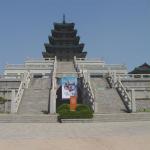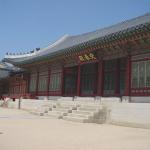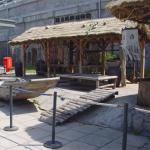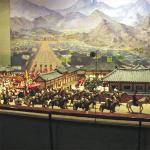A Historical & Cultural Visit
Amongst all the places that I have visited while in Korea, Gyeongbok Palace was one of the most interesting one! Perhaps my deep liking for architecture especially from the yesteryears made me take special notice of it even more. Gyeongbok Palace was built some time at the beginning of the Chosun Dynasty when the Yi Dynasty moved the capital city to Seoul. This palace was, without a doubt, the main seat of power for the kings of Korea throughout the ages until present day.
One of my main likings was brought upon by the meaning of the name 'Gyeongbok'. Such a beautiful name it is, for it meant Shining Happiness. Within the peaceful sanctuary of the palace, one will not noticed just how busy the outside world is. Separating one of the busiest areas of Seoul is the main gate known as Kwanghwa-mun. This palace was built by King Taejo in the year 1395. King Taejo was the founder of the Chosun Kingdom and the palace was established during the fourth year of his reign.
Unfortunately, the happy palace was burnt down in 1592 when the Japanese invaded the country. It was left in sad ruins for more than 250 years. It was not until the year 1865 that the palace was restored to its original beauty and grandeur. Again, most unfortunate, the palace did not remain at its best for long. When Japan seized Korea in 1910, many of the beautiful buildings were torn down. Some 200 of them were demolished, leaving only about a dozen or so structures behind.
This wonderful palace had indeed gone through an ill-fated history. Over a period of 600 years or more, the building had been damaged, rebuilt and then damaged again. Although there are only a dozen buildings remaining today, yet in the past, it had hundreds of them. However, several have been rebuilt according to their original specifications. There is a map located at the front entrance to Gyeongbok Palace, showing the architectural arrangement of the complex during the later part of King Kojong's reign. There are mapped out areas such as halls, pavilions, gates, bridges, storerooms, and offices. It spans out some 419,100 square meter of grounds. Of them all, the largest surviving wooden structure now is the royal throne hall. Not only is it the largest surviving wooden structure in Gyeongbok Palace, yet it is also the largest in the country. The royal throne hall has a high ceiling and is a single-room building placed with a double-level platform. Built in 1394, this place is called Keunjeong-jeon and was used by the King for state affairs, official functions and for receiving foreign envoys. During those times, this place is where the high-ranking officials will assemble to pay respect to the King. The throne is centered towards the back of the hall. Formerly, several ritual objects were placed in that room too, however, those have been removed now.
Gyeongbok Palace has a colorful history despite its unfortunate past. The palace had been witness to the crowning of seven of twelve kings from the years 1399 through 1549. The kings include Chogjong, Sejong, Tanjong, Sejo, Seongjong, Chunjong, and Myongjong.
Some of the changes to Gyeongbok Palace are with the gates. Formerly, there were three consecutive gates placed south of the entrance, where it lies between the royal throne hall of Keunjeong-jon and the city. The gate, Keunjeong-mun can be seen in the center of the south corridor. Then there is the Hongnye-mun, which was demolished to make way for the capital. Lastly, there is Kwanghwa-mun that is placed on the outer walls of the palace in front of the capital. Now it is renovated for the National Museum. If you want to check out a breathtaking view, go towards the second pillar from the east end of the south corridor. Here, you can see a lovely view of the mountain range directly towards the north between Keunjeong-jon and Pukhan-san (the mountain range).
Then the impressive home of the Queen Dowager Cho is Chagyong-jeon. She is the mother of King Honjong, whose reign started and ended between the years 1834 to 1849. King Honjong was the 24th King of the Chosun Dynasty. The Queen Dowager's living quarters was built for her by regent Yi Huang (the Taewongun). He was the father of King Kojong. The one that all visitors see now is not the original building, but a rebuilt of the burnt down structure. In the whole of Gyeongbok Palace, the queen's quarters is the only remaining building in the palace grounds with a bedroom within it. The room is heated by an ondal heating system whilst the bedchamber is placed at northwest of the quarters. It also has a pavilion located to the southwest with an elevated floor. This is to be used during the summer months. Formerly, the living quarters also include several other buildings, walkways and a two-post gate with a roof. However, now all that we can see is the remains of a symbolic structure - a wall with symbols of longevity and a freestanding chimney in the back garden. There is also a west wall with flower and plant designs.
Amongst those that remained, the chimney is an important artifact. Designated as Treasure #810, the chimney of Chagyong-jeon is part of the wall of the courtyard. On top of this chimney are ten exhausts, which are made to look like beams and rafters of a wooden structure. This is no ordinary chimney. In fact, it has several decorations symbolizing longevity, wealth and many offsprings. There are also symbols to rid evil. Towards the lower part of the wall, you will find a large decorative panel with plaster for background. Here you will see designs of the sun, a mountain, water, clouds, a rock, pine tree, turtle, deer, crane, grapes, the fungus of immortality, bamboo, chrysanthemum, and lotus.
Now, let's get back to the panel. Above it, you will see three-square designs. There is a dragon design in the middle and a crane on both sides. Below the panel are two more square designs depicting the mythological fire-eating beasts known as Haet'ae. Both its left and right are pictures of a bat and an arabesque design. Explanations showed that the dragon picture depicts the king while the cranes are his subjects. Other pictures such as the sun, rock and turtle shows long life while the grapes symbolizes many children. Bats symbolize wealth and lastly, the Haet'ae is to repel evil and keep it at bay. Without a doubt, this chimney is the most beautiful one to remain from the Chosun Dynasty (1392 to 1910) royal palaces.
Still within the palace grounds lies Hyangwon-jeong, located far north of the palace. Built in the year 1867, Hyangwon-jeong is a pretty hexagonal-shaped pavilion that is surrounded by a lotus pond. The pond has its unique properties for King Kojong specially instructed for the pond to be dug towards the south while the pavilion is built on an island in the pond. The King had spent many happy moments strolling across the pavilion as it was connected to the north shore of the pond by a bridge known as Ch'wihyang-gyo. The bridge and the pavilion are off limits to visitors. They can only enjoy the view and take as many photographs as they wish. It is without a doubt, Korea's most painted and photographed location.
Initially, it was presumed that Hyangwon-jeong is a building with two floors. But in actual fact, it is a three-storied building, if you include the structure below the first floor. Its hexagonal plane has railings around it. As for the bridge, after having been damaged, was rebuilt again after the Korean War in 1953. However, the bridge this time was extended to the south shore of the pond. Previously there was a wall at the east side of the pond that is double-gated towards the south making the place more private and secluded.
Of course, not forgetting, there is Kyeonghoe-ru, which is the largest pavilion in the whole of South Korea. So important is this place that it was officially designated as National Treasure #224. An interesting building of intricate architecture, Kyeonghoe-ru is set in a lotus pond and is supported by a total of 48 stone pillars. It is also at this place that the founder of the Chosun Dynasty and builder of Gyeongbok Palace, King Taejo greets and entertain his visiting dignitaries. A favorite place of the king, the building was built on this man-made lake towards the western section of the palace. For its purpose and favor in the eyes of the king, he named Kyeonghoe-ru for "joyous meeting".
During the reign of King Daejeong (1401-1408), the lake and the structure was enlarged according to the king's instructions. The Minister of Manufacturing and Construction (Pak Cha-chong) was ordered to build a square with long stone to support the dragon-shaped island on which the large pavilion can be constructed upon. It was then that the 48 dragon-sculptured stone pillars were built to support second floor. With additions, two more islets were made in the lake.
Unfortunately, this beautiful place all visitors are looking at now is not the original Kyeonghoe-ru structure as it was actually burnt down during the Japanese invasion in the year 1592. It was totally gone except for the stone supports. It wasn't until many years later (1867) that the place was rebuilt under the instructions of King Kojong. It was also then that Gyeongbok palace was rebuilt. Sadly enough, the new pillars that replaced the old ones were not as spectacular or splendorous as the previous ones. New additions include animals carving on the stone bridges and railings. Other stone structures include the Lotus Pond, Lotus Platform and dragon-shaped conduits found along the lake. It was then that this pavilion was used for royal banquets during the Chosun period and today, special functions are held there too.
Of course, we must not forget about the Yolsang Chinwon Spring that was here way before the palace was built in the year 1395. The pureness of the water is amazing and its coolness soothes the throat and is good for drinking. It flows into the adjacent Hyangwon-ji pond. There is a specially built stone trough that ensures the water supply goes to the pond without disturbing the serenity and reflection of the pavilion and trees. Such a carefully thought off idea has indeed kept the tranquility of the place intact for years. Even better is that the waterway makes two turns at right angles to doubly ensure that the water flow stays consistent. Such care is taken into the concept and maintenance of the place.
Of course, one of my favorite parts within Gyeongbok Palace is the National Folk Museum. Just outside its entrance at a park are breathtaking views of the mountains behind and a panoramic view of the surrounding greenery, which was absolutely beautiful and memorable as it was springtime when I was there. Also at the entrance, there are little replicas of homes from days gone by, featuring little wooden huts with thatched roofs. Replicas of their household items including pottery and other necessities are there as well. Right above the door of a hut hangs a string of dried chili. The tour guide explained that in the olden days, when a baby boy is born to a family, the happy family will hang out the string of dried chili to symbolize that a male has been born to the family. When it is a girl, there will be no indication whatsoever. Sexist or otherwise, such is the culture during those times.
The museum as a whole is made up of three interconnected buildings. Here you can also see various samples of traditional Korean architecture depicted by the high roofs on some of the tall buildings on the palace grounds. You can see these roofs from almost anywhere. Pointy, pagoda-like structures that are most interesting!
Within the museum, you will get to see Korean history from various periods, including pre-history right through the Japanese occupation and more. There are intricate replicas and paintings showing the various ways of life, including the making of glass sheets and war times. There are also astrological findings and wooden books, as well as ceremonies and festival depictions. During the time when I was there, there was also a special exhibition showcasing the history and other relics from their neighboring country, Japan. This was presumably done in view of the harmony of the World Cup 2002. Located at Jungang Hall, the center of the three wings, visitors will occasionally see different exhibitions that change periodically.
If you would like to bring home a souvenir, you may visit the souvenir shop where you can find various traditional Korean handicrafts and books of the history and culture of Korea (in English and Japanese translation). The museum is open on all days except every Tuesday and New Year's Day. From the months of March to October, opening hours are from 9 am to 6 pm whilst from November to February, the place is open from 9 am to 5 pm. If you are part of a tour, your admission fee is most probably take care of, however, as an independent traveler, you will have to pay KRW700 for adults and KRW300 for children/students.
So if you are on a cultural appetite, Gyeongbok Palace is the place for you. Not only is it educational, but you will also get to enjoy the lovely scenery, gardens and parks. There will be lots of photo-taking opportunity, so don't forget to load up the camera!
Disclaimer: The spellings of buildings/locations are to the best of my ability. My sincere apologies for any mistakes.
 ThingsAsian
ThingsAsian


















